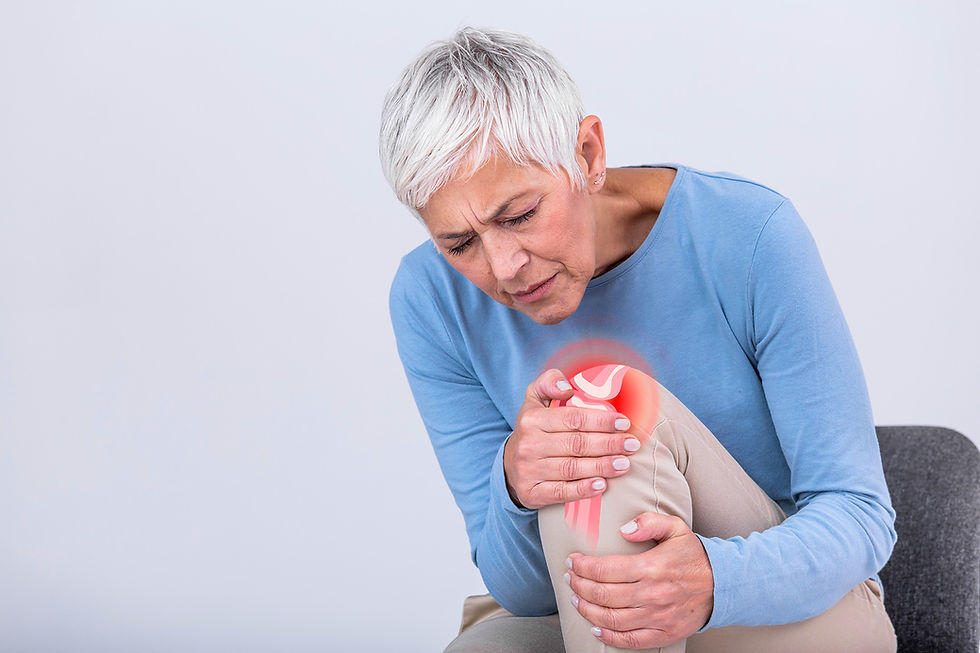Balance, Joint Movement, and Stability as You Age — How Physiotherapy Helps
- Ashleigh Low

- Oct 6
- 3 min read
Updated: Oct 7

One of the insidious but often unnoticed changes with aging is in balance and joint mobility. You might not realize that the ankles and knees often lose range of movement before the hips. Your body then has to compensate.
The loss of ankle dorsiflexion, reduced knee flexion/extension speed or strength, stiff hips — all of this shifts how you walk, how you react when you slip, and increases your risk of falls. Maintaining balance is thus a crucial part of movement and independence.
In this post:
What changes in joint movement and balance happen with age (men & women)
What exercises help maintain balance (especially focusing on ankles, knees, hips) with evidence
The role of mobile physiotherapy
What changes in balance & joint movement happen as we age — men & women
Ankle mobility: The ankle joint becomes less mobile, less dorsiflexion, plantar flexion, and proprioceptive feedback — with age. The muscles and tendons around it stiffen or weaken. This often shows up first as poor adaptation to uneven surfaces or difficulty recovering from small stumbles.
Knee function: As we age, we experience less knee extension/flexion strength, slower contraction speeds, potential cartilage degeneration, and reduced joint proprioception.

Hip compensation: As the ankle and knee weaken, the hips have to compensate — doing more work, often increasing torque and strain. Keeping hips mobile and glutes strong is essential.
Men vs Women: Women may experience a steeper decline in hip strength and mobility post-menopause, partly due to hormonal changes and historically lower engagement in strength training. But both sexes experience reductions in joint mobility, proprioception, strength, and reaction time.
Balance decline: Balance worsens as proprioception, vision, and vestibular input decline. The Mayo Clinic recommends balance training for older adults to prevent falls.
What exercises help maintain balance, ankle/knee/hip mobility & strength — evidence & practice
While there are fewer RCTs breaking this down joint-by-joint, clinical guidance and observational data give us clear direction.
Balance Exercises
Adapted from the Mayo Clinic:
Single-leg stands: Start with support, progress to freestanding (~30 sec each side).
Weight shifts: Side-to-side and forward-backward shifts build control.
Heel-to-toe walking: Enhances coordination.
Sit-to-stand exercises: From a firm chair, without using hands.
Ankle Mobility & Strength
Toe & heel raises: Improve dorsiflexion and plantar flexion.
Stretching the calves: Helps regain ankle range.
Balance on foam/unstable surfaces: Builds proprioception and reaction.

Knee Mobility & Strength
Squats & lunges: Build quadriceps and hamstring strength.
Step-ups: Improve functional strength and joint control.
Slow knee bends: Target full extension/flexion.
Hip Strength & Mobility
Side leg lifts, clamshells, bridges: Target hip abductors and glutes.
Lunges & step-ups: Encourage multi-joint control and mobility.
Functional & Agility Training
Walking on grass/gravel/curbs
Stepping sideways and backwards
Quick turns/pivots
How often?
Balance training: 2–3x/week minimum; ideally integrated into daily life.
Mobility & stretching: Daily or every other day.
Strength training: At least 2x/week.
The Mayo Clinic recommends combining balance, strength, and flexibility training for overall stability and injury prevention.
How Mobile Physiotherapy Supports Balance & Joint Health
Mobile physiotherapy provides a practical and personalized way to preserve balance and mobility:
One-on-one assessment in your home of joint mobility, proprioception, and balance
Customized programs for ankle, knee, and hip strength
Home-safe environments: We use your stairs, furniture, and home setup for real-world exercises
Monitoring & progression: As you gain strength and stability, we help you level up safely
For many older adults, getting to a clinic is a challenge. Mobile physio removes that barrier, bringing expert support directly to your doorstep.
Balance and joint mobility often decline slowly — until they matter most

Whether it’s to prevent a fall or move confidently through your day, staying steady is key. At ĀLow Physio, we offer mobile physiotherapy services that come directly to your home.
We’ll assess your:
Ankle, knee, and hip mobility
Balance & proprioception
Strength & functional movement
Book your in-home balance & mobility assessment today at www.alowphysio.com
Stay independent. Walk confidently. Age with stability.




.png)



Comments